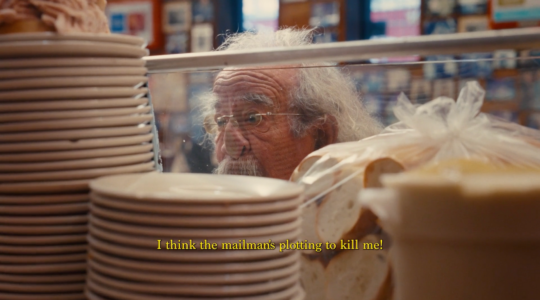The immense capacity of the human animal for pointless violence that runs counter to its best interests never ceases to amaze. Or it just never ceases.
Consider the history of an independent modern India. Conceived and brought to life by the work of one of the world’s greatest advocates of nonviolence, Mohandas Gandhi, it is a nation that has known terrible outbursts of sectarian violence within and brutal combat without for its entire history. Could it be possible, however, to reverse this process?
That question keeps nagging at the viewer throughout “Budrus,” a new documentary film directed by Julia Bacha, which has its North American premiere at the Tribeca Film Festival.
Budrus is a West Bank village of some 1,500 Palestinians, most of whom make a modest living from agriculture, particularly from some 3,000 olive trees just outside the town. In 2003 when Israel began construction on the separation barrier, plans had the wall literally surrounding Budrus and five other nearby villages. The wall would have run through the village cemetery and would have cut off the villagers from the olive trees.
Ayed Morrar, a lifelong resident of Budrus and Palestinian activist, would not accept that plan. An organizer by temperament, he called a village meeting and began a program of nonviolent resistance. That resistance would eventually include 55 demonstrations over an unspecified amount of time, and develop alongside escalating provocations from Israeli soldiers and border police. It all culminated in a partial occupation of the town and the involvement of an impressive spectrum of organizations and individuals. Morrar managed to bring under one umbrella not only Fatah and Hamas, but also Israeli peace activists and environmentalists and, most tellingly, local women.
Bacha tells this story succinctly; the film is about 80 minutes long. She gives a considerable amount of screen time to Israeli army spokesman Doron Spielman and border police officer Yasmine Levy, who bring a certain amount of balance to the proceedings. But the center of the film belongs to Morrar and his daughter Iltezam, a 15-year-old who insisted that the village women have an active role in the marches. As a result, the film becomes very much the drama of a small group of people discovering that they have the power to change the course of events that might otherwise be determined by distant bureaucrats for whom they are not even dots on a map.
And the presence of Levy, in particular, suggests the basic humanity of the Israeli antagonists. While Spielman is a handsome, hyper-articulate professional spin doctor who never talks about his own feelings or experiences, Levy is an archetypal good cop, streetwise and humane, cognizant of how much she shares with the people she is confronting. She adds nuance and warmth to the film, offering something more than the window dressing of balance that plagues too many recent documentaries on the conflict.
Midway through the movie there is a brief segment in which the Palestinian Authority’s prime minister visits Budrus. He goes around glad-handing everyone in sight, just like politicians anywhere in the world. Watching this scene, one wonders why it has been included — it adds nothing to the drama unfolding in and around the village. Then Bacha cuts to Morrar, who shakes his head ruefully and talks about the total unwillingness of the prime minister to actually engage with the local activists. In short, he’s just another bureaucrat looking for a photo-op. The distance and unconcern of politicians and institutions runs deep on all sides, and it becomes a significant subtext to the film, adding layers of meaning and nuance that too many comparable films lack.
“Budrus” is not perfect. One wishes for a more textured sense of the daily lives of the villagers. The film’s timeframe is strangely undefined. While Bacha uses graphics effectively to delineate the geography of the wall, one has no sense whatsoever of why the government chose its original projected path, which looks like the work of a hyperactive toddler with an Etch-a-Sketch.
But for all its shortcomings, “Budrus” is a strong piece of work from intelligent filmmakers. The Palestinian cause is one that had its political birth in violence. A move towards nonviolent resistance would involve reversing the evolutionary trend of places like India. Perhaps the only way to achieve peaceful resolutions is the one that emerges from “Budrus,” for people to meet one another face to face and thereby recognize their mutual humanity. At one point in the film, Ahmed Awwad, a Hamas activist, says, “We had heard that there were some Israelis who wanted peace with the Palestinians, but [at] these demonstrations … I saw these Israelis in real life, it wasn’t just something I heard about.” As the great Franco-Jewish philosopher Emmanuel Levinas said, it is by looking into the face of the Other that we take on a moral responsibility that begins with the Torah’s edict, “Thou shalt not kill.”
Of course, there are those unfortunates who look into a mirror and do not entirely recognize their own humanity. The French Jewish singer-songwriter Serge Gainsbourg appears to have been one of those, if the new biopic by Joann Sfar is any indication. “Gainsbourg, Je T’Aime . . . Moi Non Plus,” another Tribeca selection, is a delightfully unconventional take on its relentlessly controversial title character, highlighting his lifelong battles with anti-Semitism, booze, drugs and self-destructive womanizing. Sfar is a comic-book artist whose graphic novel based on Gainsbourg’s life is the basis for this film, and her unusual background leaves the first-time filmmaker free to experiment, with frequently hallucinatory results.
Gainsbourg had one of those so-ugly-it’s-beautiful faces and a voice that towards the end sounded like the late French singer Gilbert Becaud gargling battery acid. In the context of his work, he created for himself a number of alternative personae, and that cue gives Sfar the inspiration for a number of animated alter egos that alternately haunt and inspire Gainsbourg (brilliantly played as an adult by Eric Elmosnino). He is followed through childhood by a bouncing animation of an anti-Semitic caricature he spots in Nazi-occupied Paris. He is guided and mocked by La Gueule, an alternate personality who tells him bluntly, “You play piano better at night,” inspiring him to pursue a cabaret career. He encounters a talking cat and other cartoon characters throughout the film.
Support the New York Jewish Week
Our nonprofit newsroom depends on readers like you. Make a donation now to support independent Jewish journalism in New York.
“Gainsbourg” is a witty, frequently intoxicating rebuff to the usual biopic clichés, and this befits its iconic and iconoclastic hero. But originality doesn’t rescue it from the scourge of almost all rise-and-fall stories: the rise to fame is inevitably more interesting than what follows it. The film’s last half-hour could profitably be cut in half, and yet still has a rushed feeling. And there is a lot of “inside baseball” that will go past a non-French audience. But the final result is engaging and peculiar, rather like Serge Gainsbourg himself.
The ninth annual Tribeca Film Festival runs from April 21-May 2 at numerous venues in lower Manhattan. In addition to the films being shown, there is a wide range of related events including numerous panel discussions, and director and star appearances. For information, go to www.tribecafilm.com/festival.
|
Signup for our weekly email newsletter here. Check out the Jewish Week’s Facebook page and become a fan! And follow the Jewish Week on Twitter: start here. |
The New York Jewish Week brings you the stories behind the headlines, keeping you connected to Jewish life in New York. Help sustain the reporting you trust by donating today.




